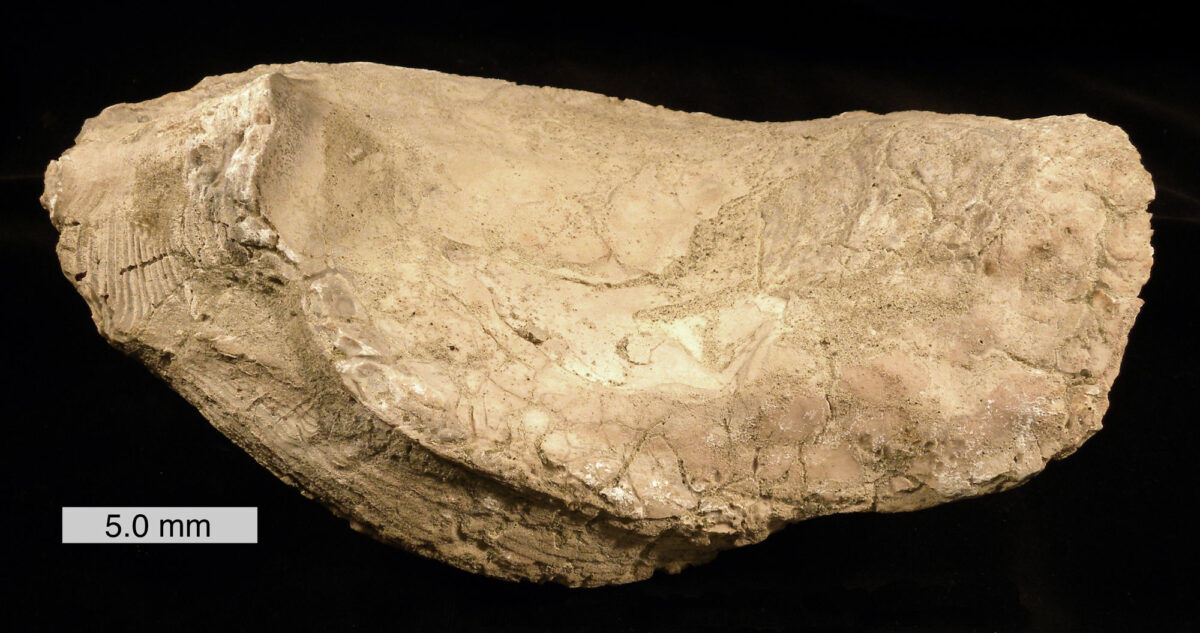
Page snapshot: Introduction to the fossils of the Coastal Plain region of the south-central United States.
Topics covered on this page: Introduction; Mesozoic fossils; Cretaceous marine fossils; Cretaceous dinosaurs; Dinosaurs of Oklahoma and Texas; Dinosaurs of Arkansas and Missouri; Cenozoic fossils; Paleogene fossils; Paleogene whales; Paleogene terrestrial fossils; Neogene fossils; Quaternary fossils; Resources.
Credits: Most of the text on this page comes from "Fossils of the South Central US" by Warren D. Allmon and Alex F. Wall, chapter 3 in the The Teacher-Friendly Guide to the Geology of the South Central US, edited by Mark D. Lucas, Robert M. Ross, and Andrielle N. Swaby (published in 2015 by the Paleontological Research Institution; currently out of print). The book was adapted for the web by Elizabeth J. Hermsen and Jonathan R. Hendricks in 2022. Changes include formatting and revisions to the text and images. Credits for individual images are given in figure captions.
Updates: Page last updated March 29, 2022.
Image above: Inside of a valve (one part of the shell) of a giant Eocene oyster (Crassostrea gigantissima) from Texas. Photo by Mark A. Wilson (Wilson44691, Wikimedia Commons, Creative Commons Attribution-ShareAlike 3.0 Unported license, image resized).
Introduction
The sediments that accumulated to form the Coastal Plain of Texas and Louisiana were deposited by numerous rivers that drained the land to the north and northwest. This process began in the Late Cretaceous, and the Mississippi River continues to drain the central US today, contributing to the coastline of the Gulf of Mexico. Late Creatceous sediments define the edge of the Coastal Plain, forming an irregular northeast-southwest-oriented band farthest from the modern coastline. Roughly parallel bands of sediments of decreasing age outcrop toward the coast, with the youngest sediments accumulating right at the shore today. In a few places on the edge of Coastal Plain, Early Cretaceous rocks that yield fossils are exposed.
The northward extension of the Coastal Plain into regions far from the Gulf Coast today (like Missouri and Arkansas) is called the Mississippi Embayment. This region was a low spot (basin) that was flooded during the Cretaceous, and sediments of Cretaceous age and younger have been filling in the basin since Cretaceous time.
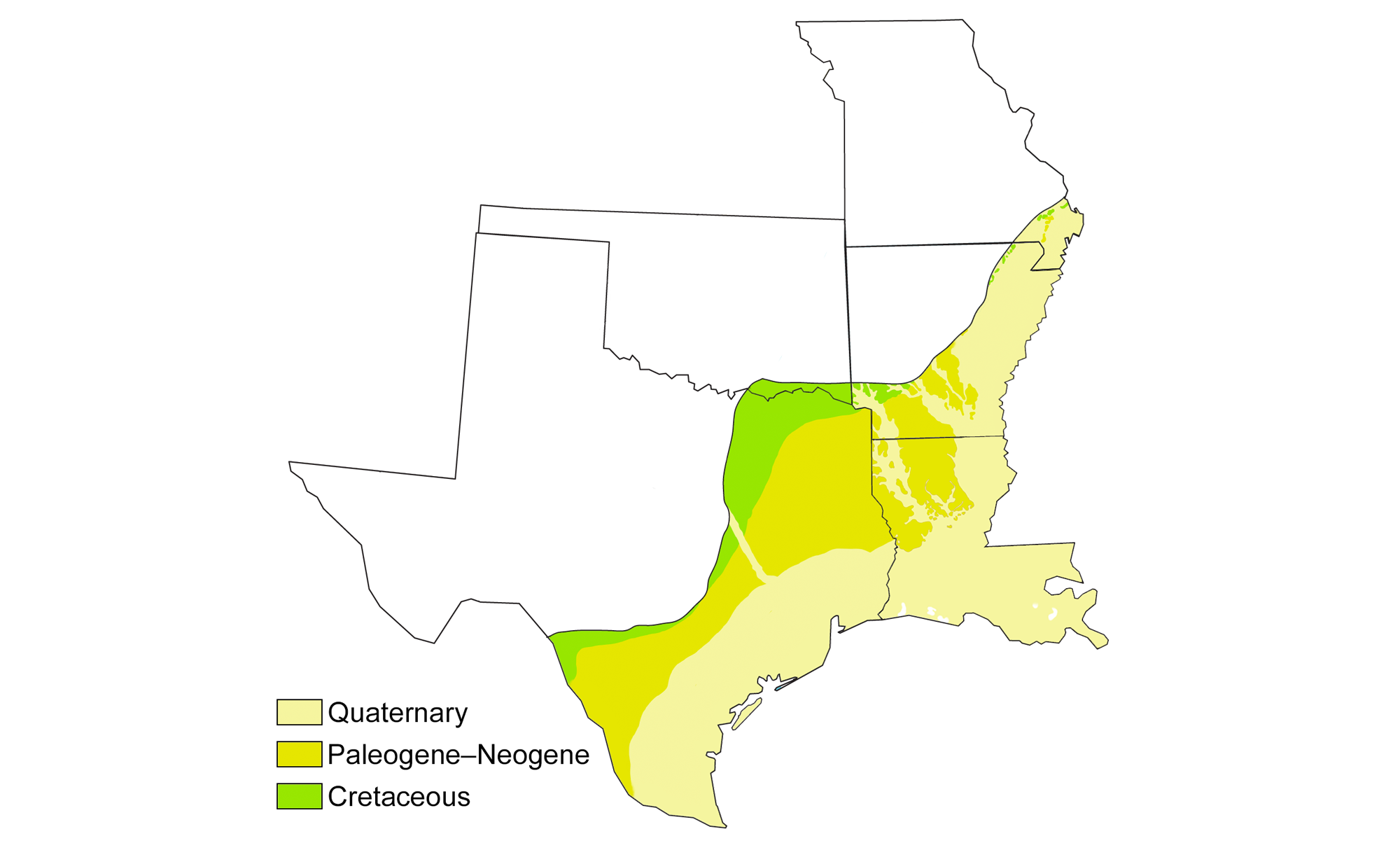
Generalized geologic map of the Coastal Plain of the southeastern U.S. Original map by Wade Greenberg-Brand, modified for Earth@Home project.

North America in the Late Cretaceous, about 75 million years ago, showing the flooded Mississippi Embayment region. Reconstruction created using basemap from the PALEOMAP PaleoAtlas for GPlates and the PaleoData Plotter Program, PALEOMAP Project by C. R. Scotese (2016); map annotations by Elizabeth J. Hermsen for PRI's Earth@Home project (CC BY-NC-SA 4.0 license).
Mesozoic fossils
Cretaceous marine fossils
In Texas and Oklahoma, fossil-bearing Cretaceous sediments are found from the base of the Edwards Plateau near the Mexican border to Dallas and into the sliver of Coastal Plain on the eastern half of the Oklahoma-Texas border. These Cretaceous sediments are frequently rich in fossils, including shark teeth and ammonites, both the usual coiled forms and unusual irregular or uncoiled forms known as heteromorphs. Oysters and other bivalves (including Inoceramus) and echinoids are also present, as well as rare mosasaur and plesiosaur remains.

The bivalve Inoceramus comancheanus from the Lower Cretaceous Duck Creek Beds (Washita Group), Denison, Texas. These Lower (Early) Cretaceous fossils may have been collected from near the Red River (Oklahoma-Texas border), where older rocks are exposed. Photo of YPM IP 592348 (left) by Christina Lutz (2016) and YPM IP 592344 (right) by Jessica Utrup (2016), Yale Peabody Museum of Natural History/YPM (CC0 1.0 Universal/Public Domain Dedication).
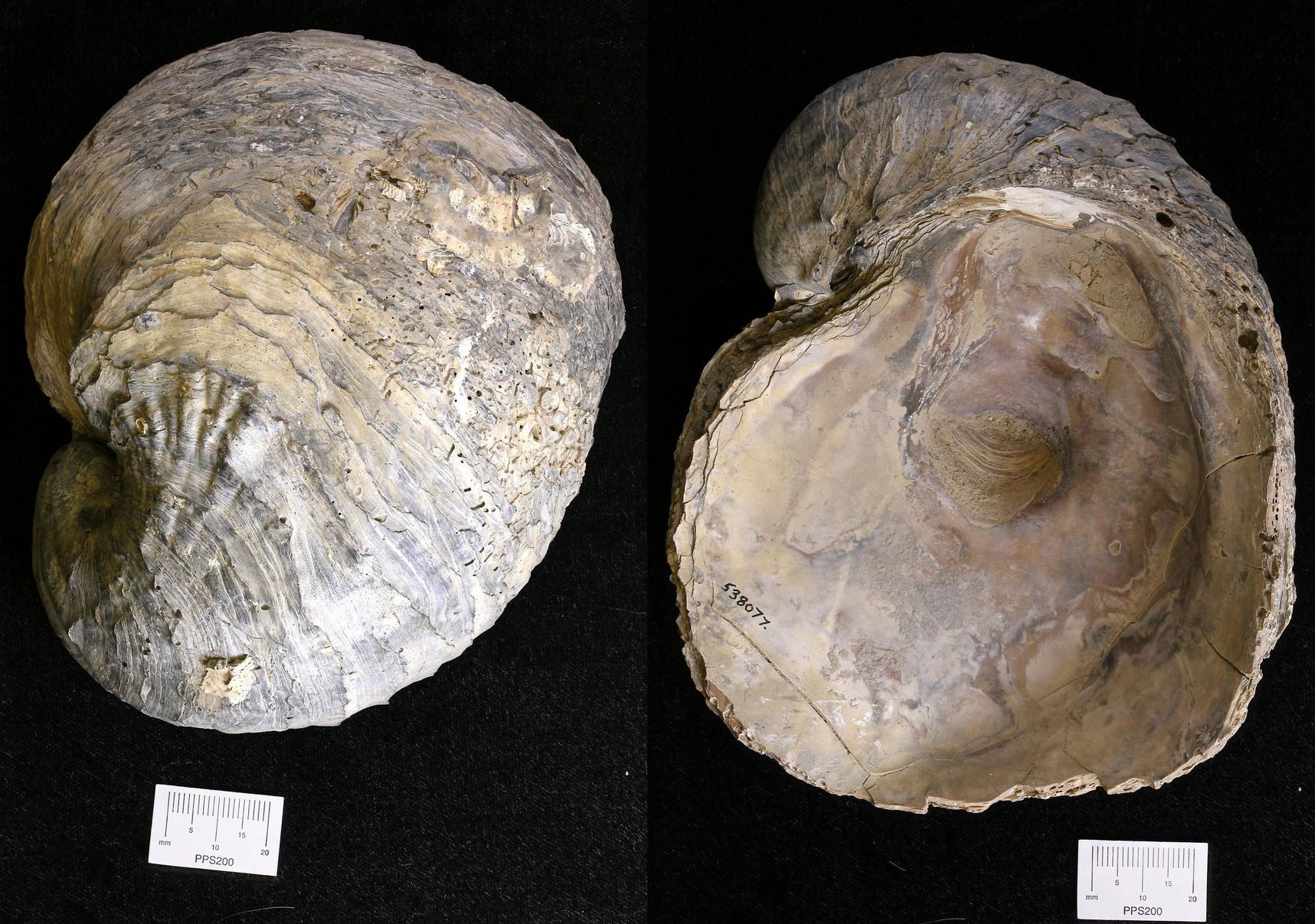
Exogyra ponderosa (an oyster, a type of bivalve) from the Upper Cretaceous Ozan Formation, Lamar County, Texas. Photo of YPM IP 538077 by Elissa S. Sorojsrisom, 2018 (Yale Peabody Museum of Natural History/YPM, CC0 1.0 Universal/Public Domain Dedication, accessed via GBIF.org).
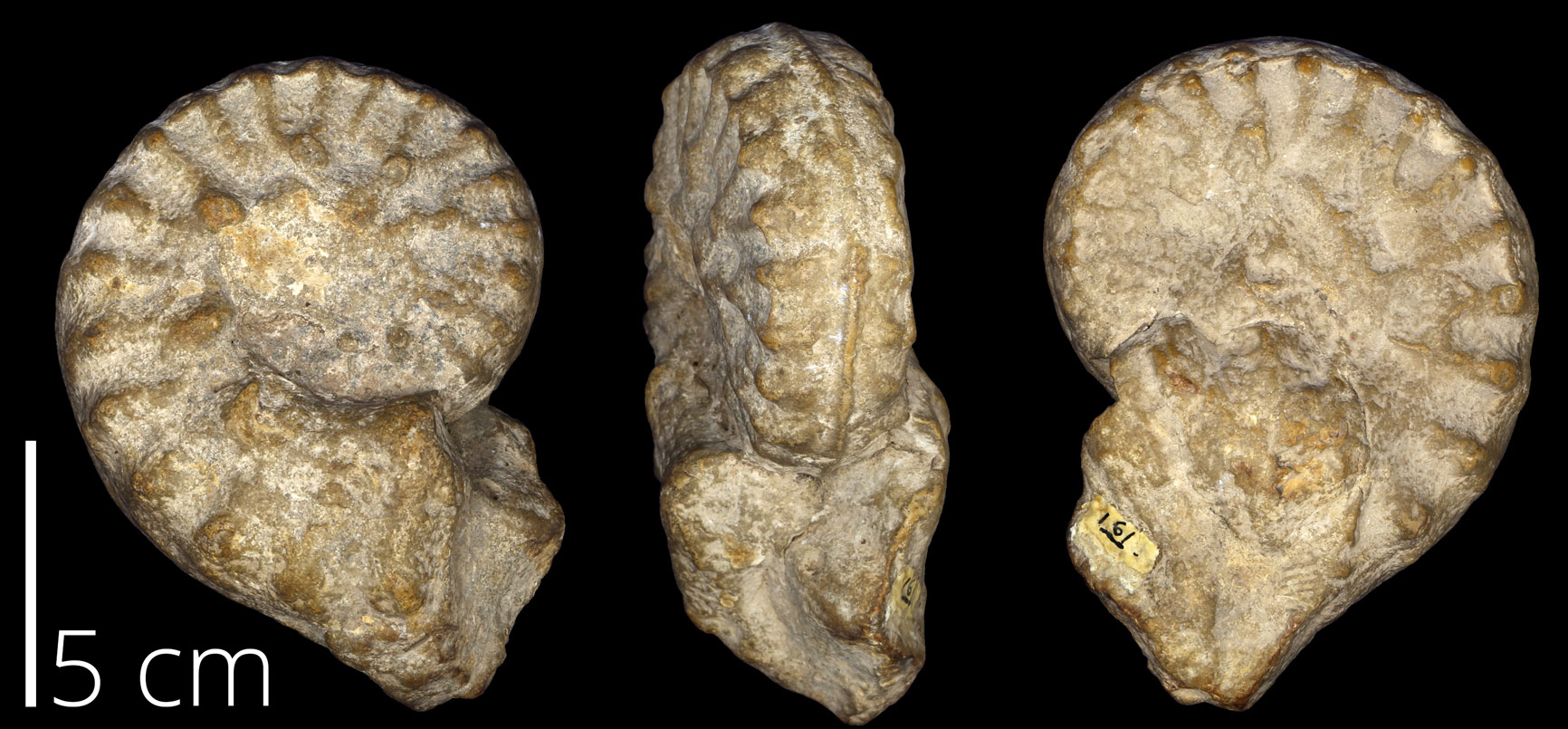
The ammonoid Mortoniceras texanum from the Upper Cretaceous (Campanian) Austin Chalk, Bell County, Texas. Photo of UNM 161 from the Cretaceous Atlas of Ancient Life, Western Interior Seaway (Creative Commons Attribution NonCommercial-ShareAlike 4.0 International license, image modified).
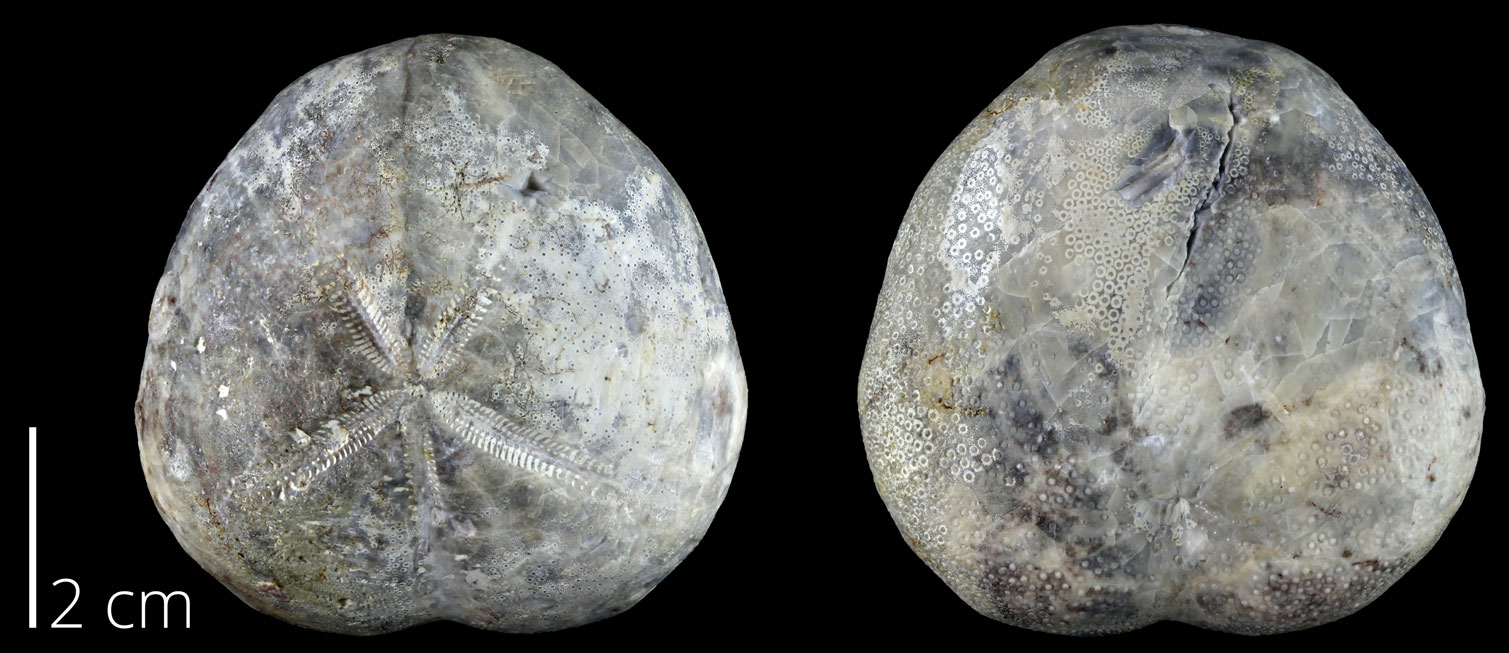
The echinoid Micraster uddeni from the Upper Cretaceous Austin Chalk, Williamson County, Texas. Photo of NPL 83027 from the Cretaceous Atlas of Ancient Life, Western Interior Seaway (Creative Commons Attribution NonCommercial-ShareAlike 4.0 International license, image modified).
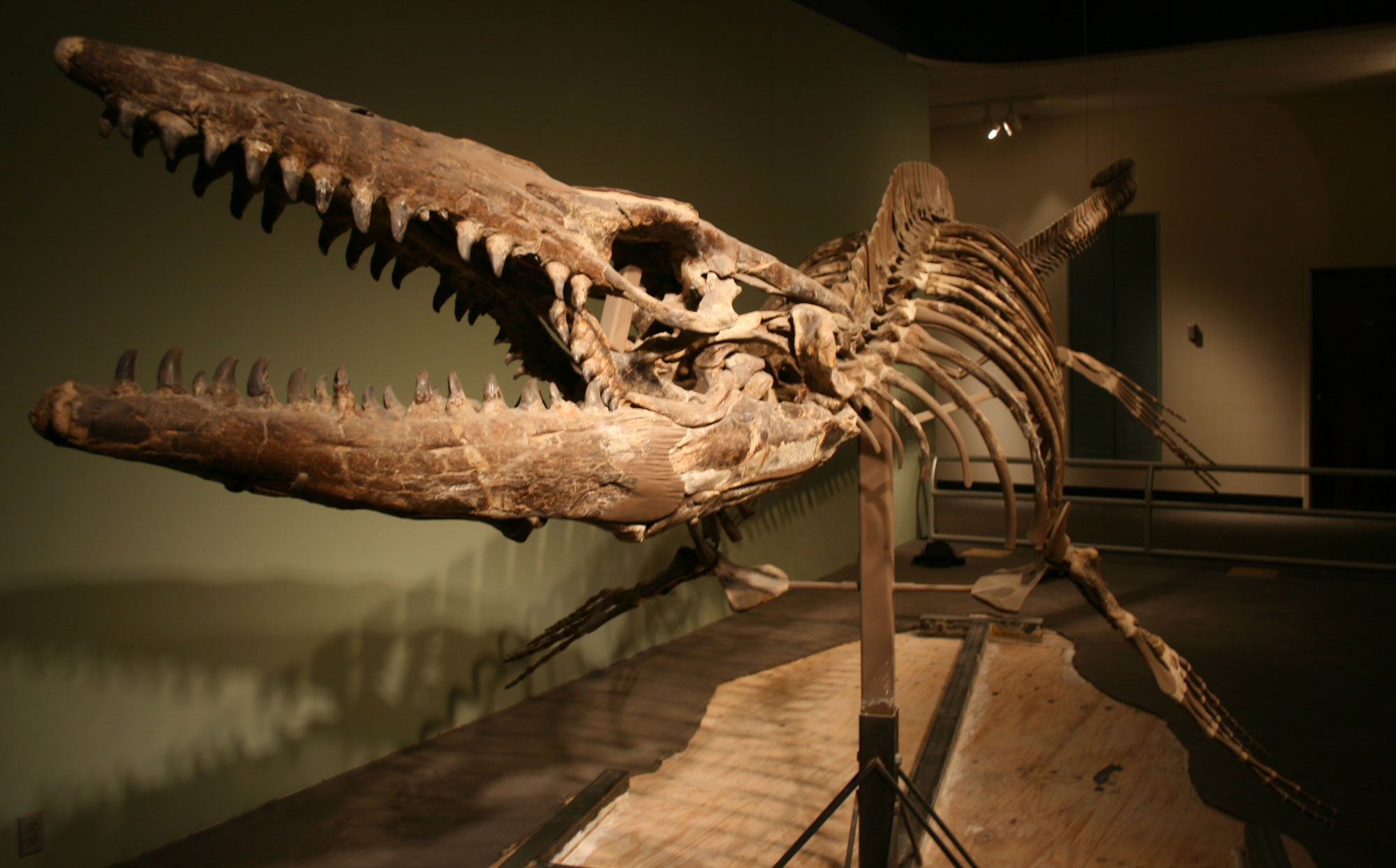
The Heath Mosasaur, Cretaceous, Rockwall County, Texas. Photo from a display at the Dallas Museum of Nature and Science (Perot Museum), Paleoaerie (blog post, "Day 2 of marine paleo-animals: Mosasaurs", Creative Commons Attribution 4.0 International license, image cropped and resized).
The line of Late Cretaceous layers continues along the landward edge of the Coastal Plain into Arkansas, bordering the Interior Highlands. This boundary forms a line from the southwest to northeast corners of the state. Cretaceous layers, however, only crop out in the corners of Arkansas, as they are buried by younger sediment in the state’s center. Cretaceous strata contain large clams and bivalves, ammonites, gastropods, echinoids, shark teeth, and the occasional marine reptile.
A few pockets of Cretaceous-aged rock are also found in Louisiana, where salt domes have pushed up through the overlying Cenozoic sediment, occasionally carrying Cretaceous shark teeth to the surface.
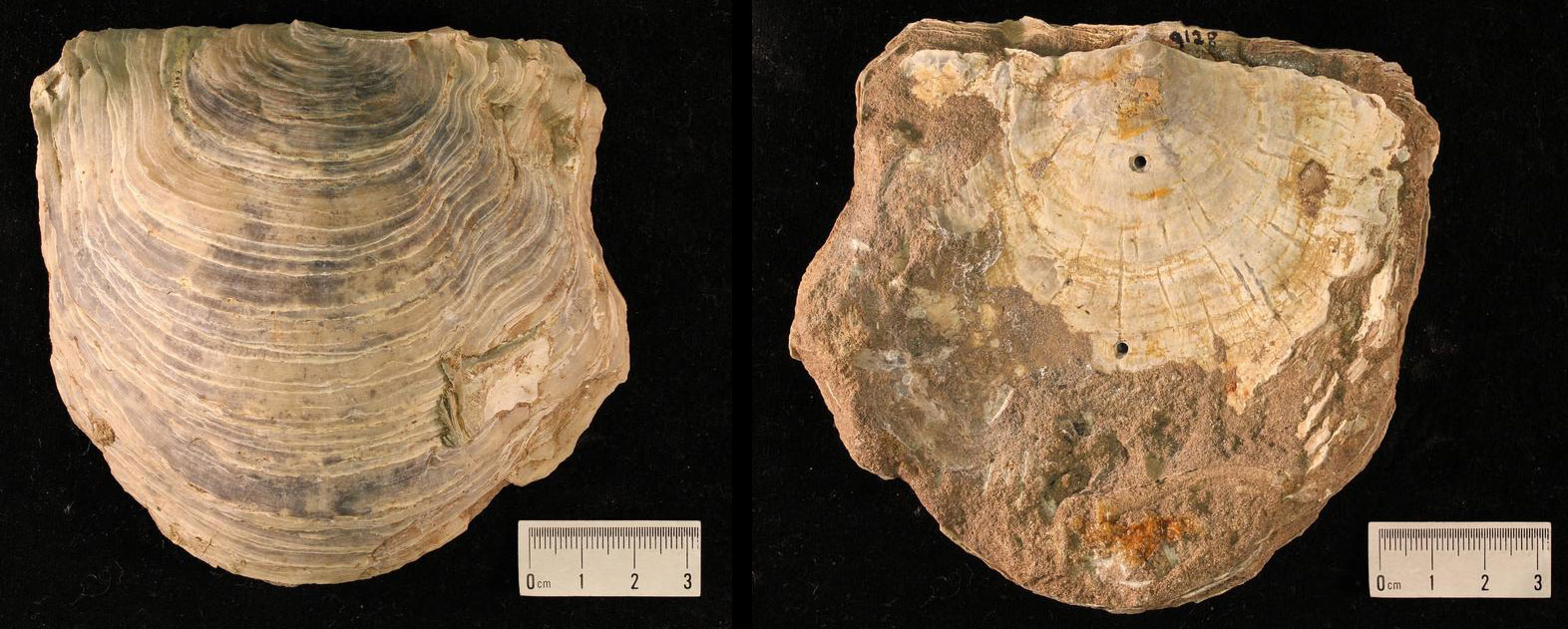
Gryphaea vasicularis (an oyster sometimes called the devil's toenail) from the Upper Cretaceous Nacatoch Sand, Clark County, Arkansas. Photo of YPM IP 009128 by Jessica Utrup, 2015 (Yale Peabody Museum of Natural History/YPM, CC0 1.0 Universal/Public Domain Dedication, accessed via GBIF.org).
Cretaceous dinosaurs
Dinosaurs of Oklahoma and Texas
The Texas-Oklahoma border area yields rare dinosaur skeletons, most spectacularly the gigantic sauropod (long-necked, herbivorous dinosaur) Sauroposeidon proteles, known from the Early Cretaceous of Oklahoma and Texas. Skeletal remains of the predatory theorpod dinosaur Acrocanthosaurus atokensis have also been found in the Early Cretaceous of southeastern Oklahoma and Texas. Dinosaur footprints that are common in Cretaceous rocks near the border between the Coastal Plain and the Great Plains regions in eastern Texas may have been made by Sauroposeidon, Acrocanthosaurus, or similar dinosaurs (see examples on the South-central U.S.: Fossils of the Great Plains page). A variety of other dinosaur remains have been found in this region, including those of tyrannosaurids.
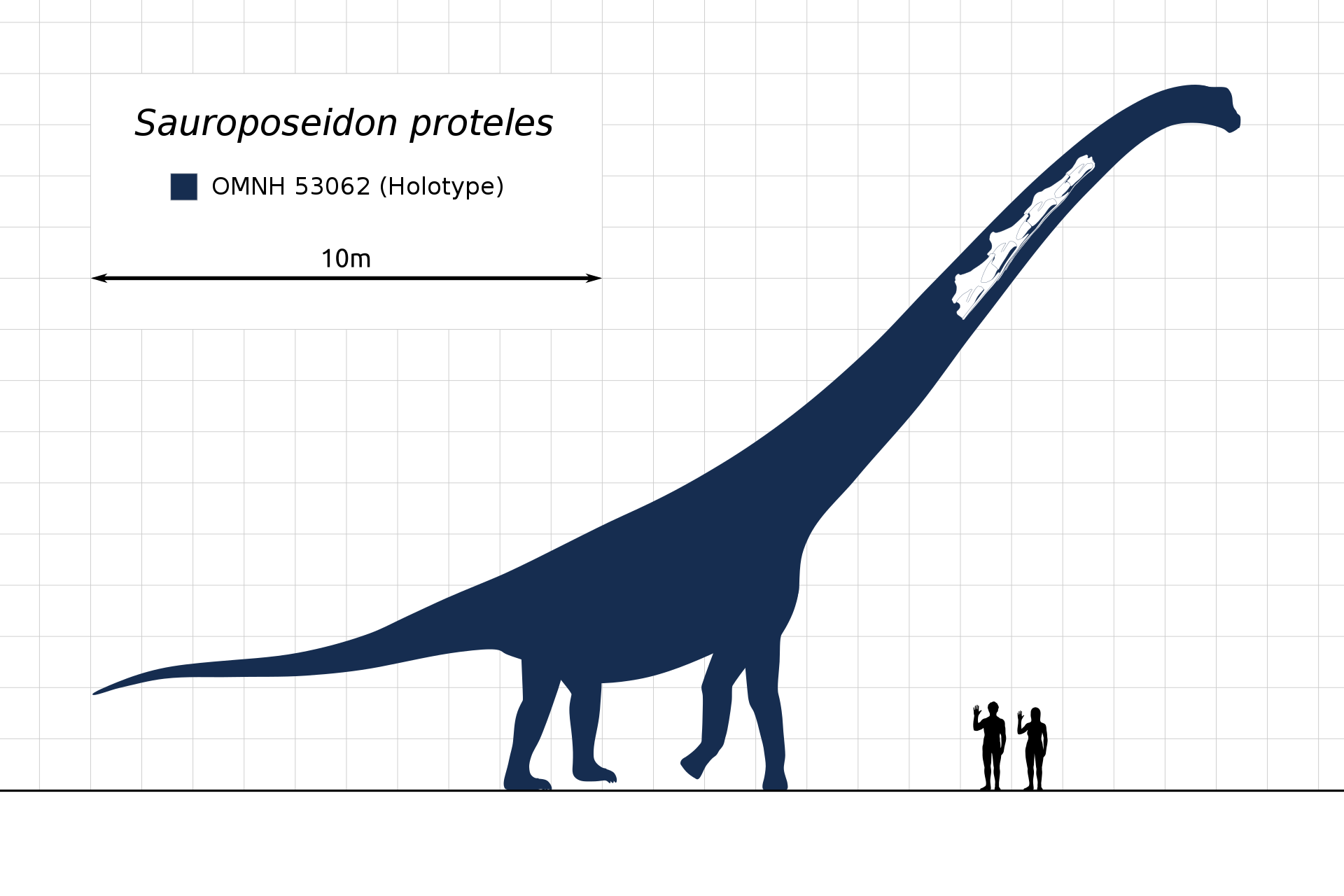
Diagram showing estimated size of Sauroposeidon and neck vertebrae of Sauroposeidon found in Oklahoma. Diagram by Steveoc 86 (Wikimedia Commons, Creative Commons Attribution-ShareAlike 3.0 Unported license).
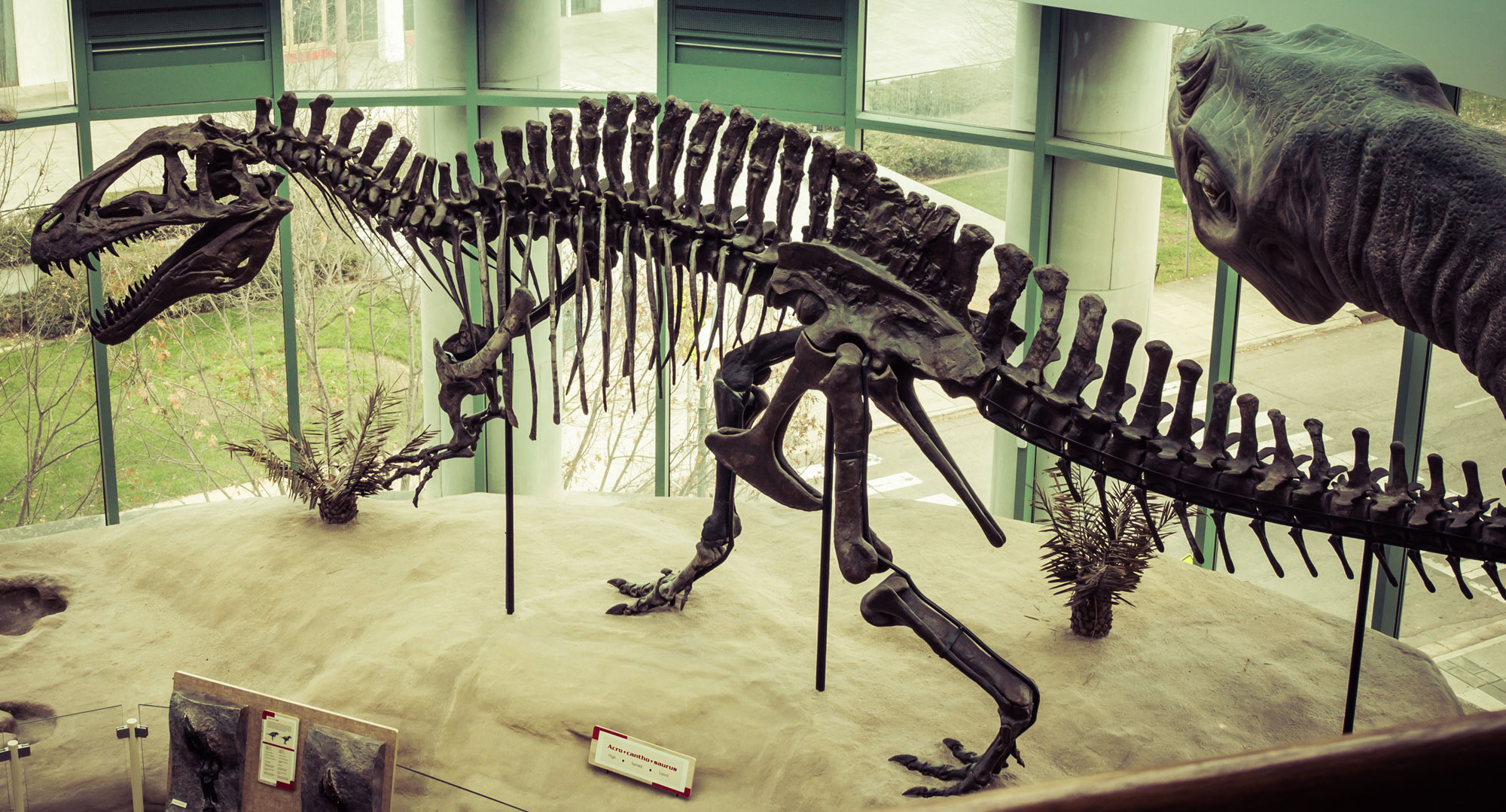
The therpod dinosaur Acrocanthosaurus atokensis from the Lower Cretaceous Antlers Formation, McCurtain County, Oklahoma. This specimen, called "The Terror of the South," was excavated in the 1980s and is on display in the Museum of Natural Science, Raleigh, North Carolina. The skeleton is 11.5 meters (37.8 feet) long. Photo by Sergey Galyonkin (flickr, Creative Commons Attribution-ShareAlike 2.0 Generic license, image cropped and resized).
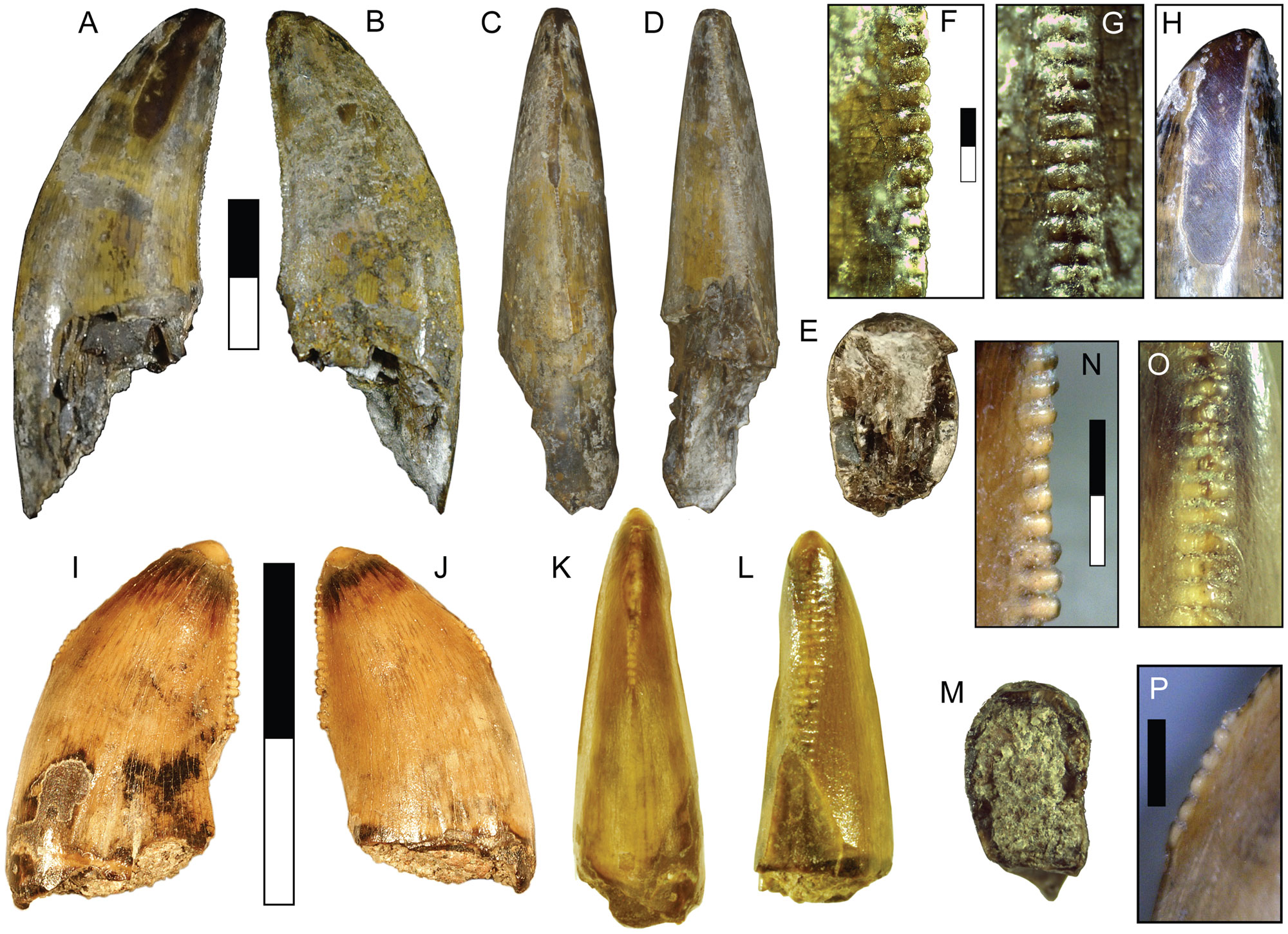
Tyrannosaurid teeth from the mid-Cretaceous Lewisville Formation (Woodbine Group), Texas. Two teeth are shown here, each from two sides (A, B and I, J), the back and front (C, D and K, L), the bottom (E, M) and details of the surface serrations (F, G, N, O, P) and wear (H). Figure 4 from Noto et al. (2022) Peer J 10:E12782 (Creative Commons Attribution 4.0 International license, image resized).
Dinosaurs of Arkansas and Missouri
Rare dinosaurs are also known from Arkansas and Missouri. The Early Cretaceous dinosaur Arkansaurus fridayi, a small theropod (predatory dinosaur with three-toed feet), was named the state dinosaur of Arkansas in 2017. Parrosaurus missourenisis, a duck-billed dinosaur, comes from the Late Cretaceous Chronsiter Vertebrate Site in southeastern Missouri. Tail vertebrae belonging to the dinosaur were first discovered at the site in the 1940s, when Lula Chronister owned the land. Interest in and excavations at the Chronsiter Vertebrate Site were rekindled in the 1970s, with parts of dinosaur skeletons recovered from the site as recently as 2021. In addition to Parrosaurus, Albertosaurus (a carnivorous dinosaur) teeth and turtle remains have been found at the site.
Exploring Arkansas: "Arkansaurus" (video via YouTube). In this video, Joe Friday describes discovering the bones of Arkansaurus.
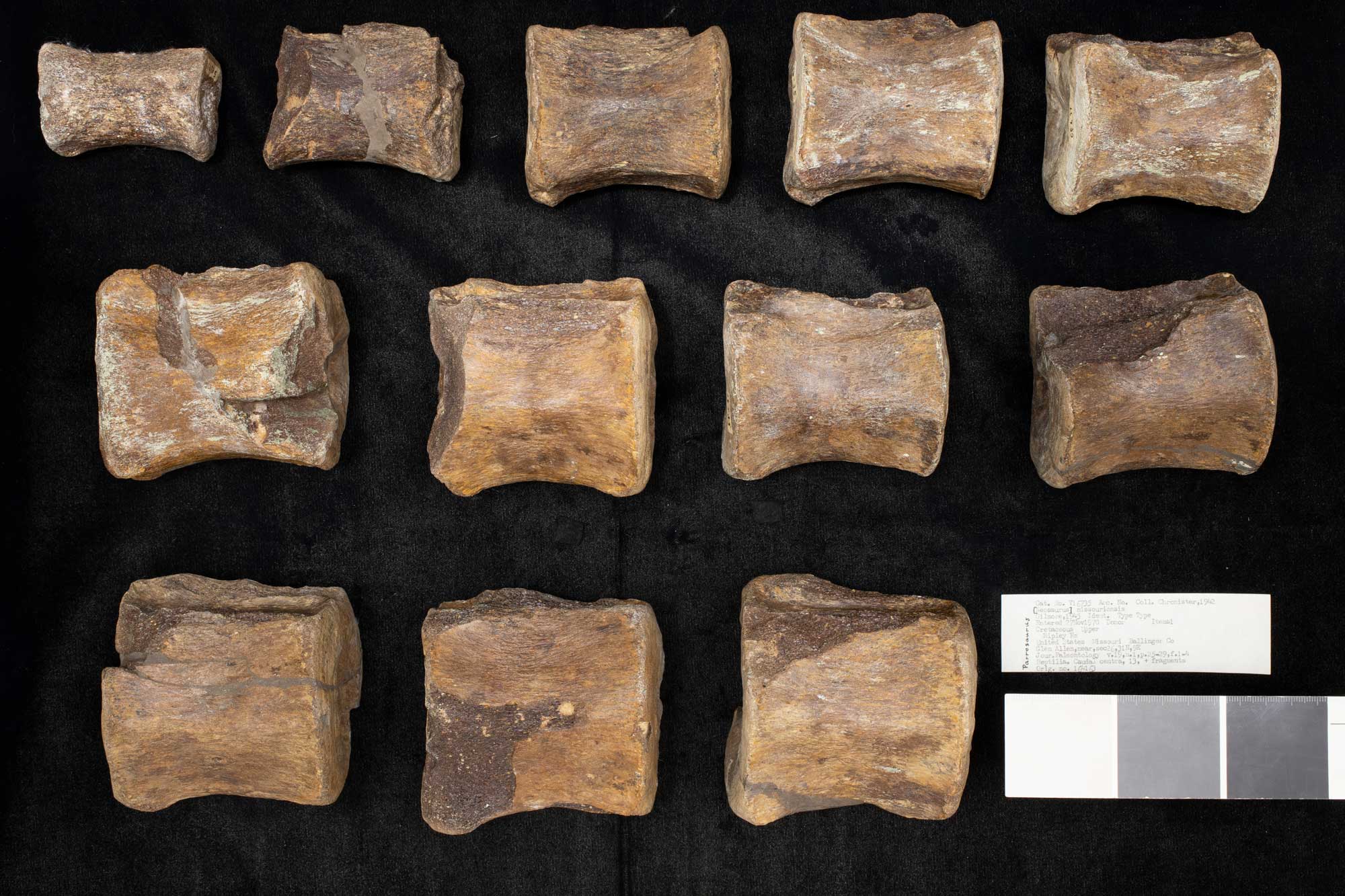
Vertebrae of Parrosaurus missouriensis (a type of duck-billed dinosaur) collected in 1942, Upper Cretaceous Ripley Formation, Bollinger County, Missouri. Photo of USNM V 16735 (Smithsonian Institution, via the flickr account of the Missouri State Archives, public domain. Original specimen data from the Smithsonian Institution, NMNH Paleobiology Department).
Cenozoic fossils
Paleogene
The great majority of sediment exposed in the Coastal Plain is Cenozoic in age. Paleogene-aged strata are, for the most part, sandwiched between the western rim of Cretaceous deposits, and the youngest layers of Neogene and Quaternary sediment, which are found nearest the Gulf and along the Mississippi River Valley. Paleogene marine deposits in Texas, southern portions of Arkansas, and northern parts of Louisiana are abundantly fossiliferous, yielding shark teeth, corals, clams, snails, and the bones of early whales.
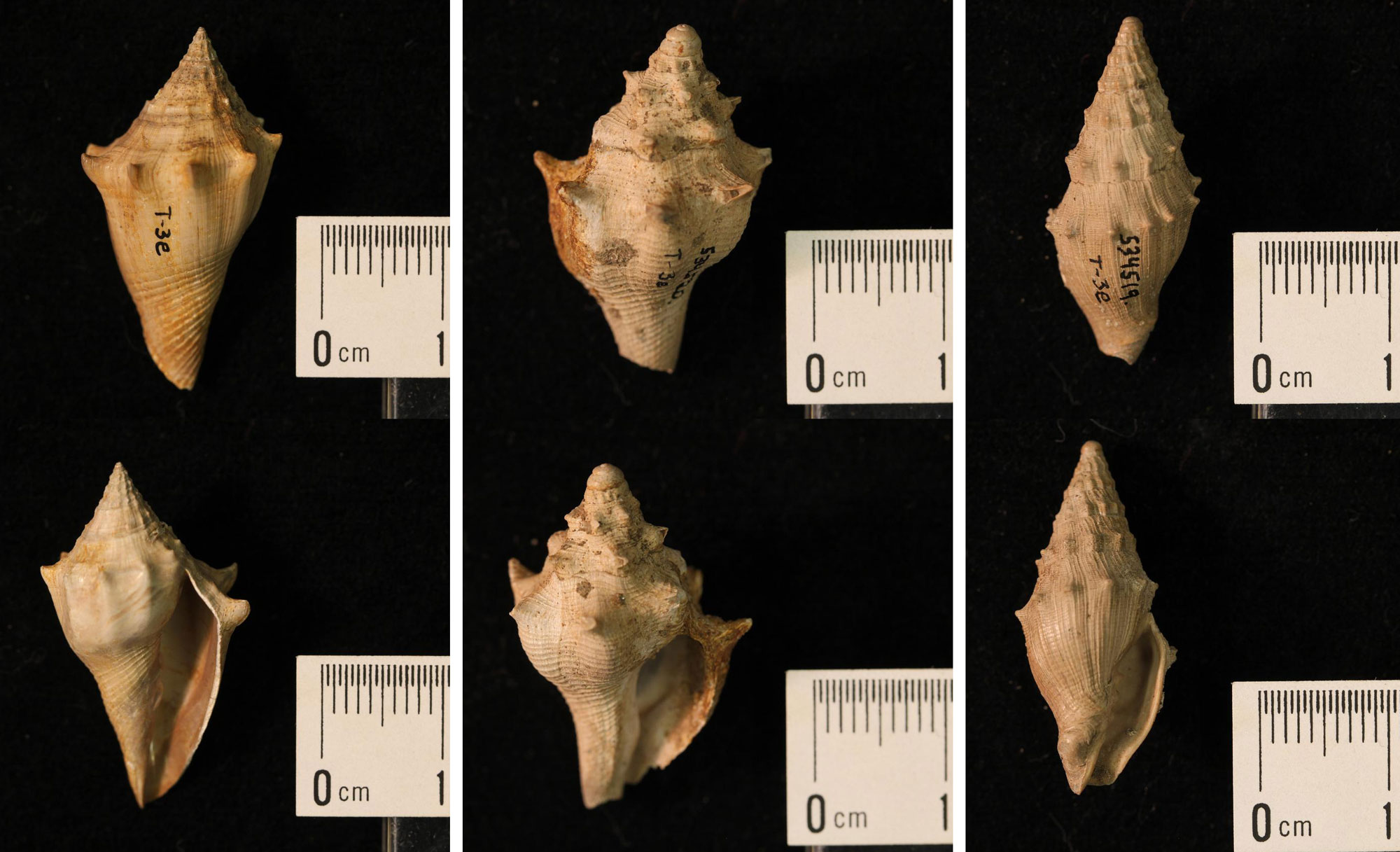
Fossil snails from the Eocene Cook Mountain Formation, Brazos County, Texas. Left to right: Athleta petrosa petrosa (YPM IP 534501), Papillina dumosa trapaquara (YPM IP 534520), Lapparia mooreana (YPM IP 534510). All photos by Jessica Utrup, 2016 (Yale Peabody Museum of Natural History/YPM, CC0 1.0 Universal/Public Domain Dedication, accessed via GBIF.org).

Fossil bivalves from the Eocene Cook Mountain Formation, Brazos County, Texas. Left: Cardita sp. (YPM IP 527152). Right: Veneroida, genus undetermined (YPM IP 527266). All photos by Jessica Utrup, 2019 (Yale Peabody Museum of Natural History/YPM, CC0 1.0 Universal/Public Domain Dedication, accessed via GBIF.org).
Abundant tiny fossils called foraminifera are found throughout the Coastal Plain’s Cretaceous and Cenozoic sediments. Foraminifera, or “forams,” as they are frequently called, are single-celled organisms (protists) with shells made of calcium carbonate. They live in the ocean in huge numbers, both at the bottom and floating in the water column, and are extremely important as index fossils and paleoenvironmental indicators in Cretaceous and Cenozoic sediments.
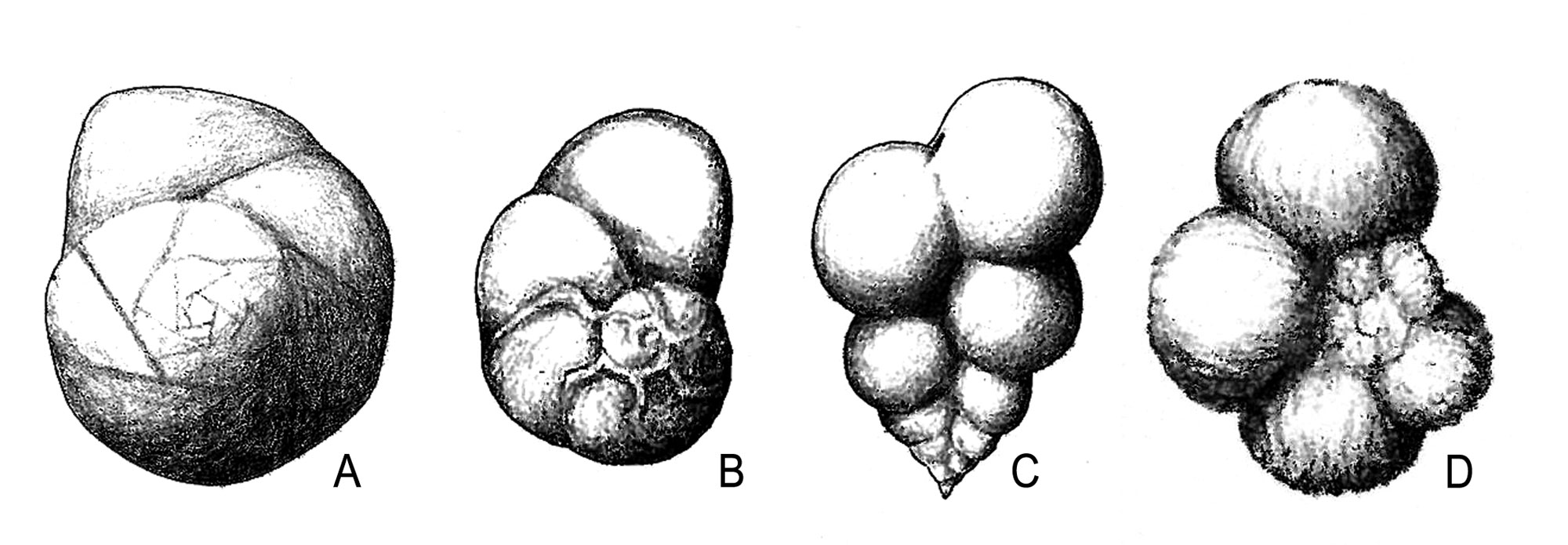
Foraminfera from the Paleogene Midway Formation, Texas. Left to right: Pulvinulina (A, 0.3 millimeters or 0.01 inches), Rotalia (B, 0.4 millimeters or 0.02 inches), Pseudotextularina (C, 0.3 millimeters or 0.01 inches), Globigerina (D, 0.4 millimeters or 0.02 inches). Illustrations from H. J. Plummer (1926) University of Texas Bulletin 2644.
Paleogene whales
Whales are most closely related to artiodactyls, or the even-toed hoofed mammals (for example, bison, deer, and hippopotamuses). Whales evolved from four-legged animals that resembled wolves and lived on land during the Eocene epoch, beginning around 55 million years ago.
The earliest whales are from the early to middle Eocene. Relatively small forms, called protocetids (a name meaning "early whales"), have been found in the middle Eocene sediments of the Coastal Plain. In the south-central region of the U.S., the protocetid Natchitochia is known from Louisiana, and protocetid bones have also been found in the Eocene Yegua Formation of Texas.
Another type of ancient whale known from the Gulf Coast is Basilosaurus. Richard Harlan first described Basilosaurus in 1843. He believed that the few bones he found belonged to a marine reptile (hence, the name that means "king lizard"). Basilosaurus was a member of an early group of whales known as basilosaurids, which included the ancestors of the two major groups of modern whales. These are the toothed whales or odontocetes (for example, porpoises and sperm whales), and the baleen whales or mysticetes (for example, humpback whales and blue whales).
Protocetids and basilosaurids inhabited the equatorial oceans during the Paleocene and Eocene. The vertebra pictured below was found in Arkansas in 1945, and is one of the northernmost early whale fossils ever found.

Basilosaurus vertebra from Arkansas. Paleontological Research Institution.
Paleogene terrestrial fossils
Plant fossils occasionally occur in the Paleogene of the coastal plain in Louisiana and Texas. Fossil fruits and seeds are known from the Whitsett Formation in southeastern Texas. They include some types of plants that grow in the Coastal Plain today, like tupelo (Nyssa). Others are found only in Eurasia, like Yua, a member of the grape family found today in eastern to southeastern Asia. Leaf fossils are also known from Louisiana and Texas.
A small deposit of Eocene amber occurs in the Claiborne Group near Hot Springs, Arkansas. Insects are preserved in this amber, including members of the groups that include beetles, flies, and ants.
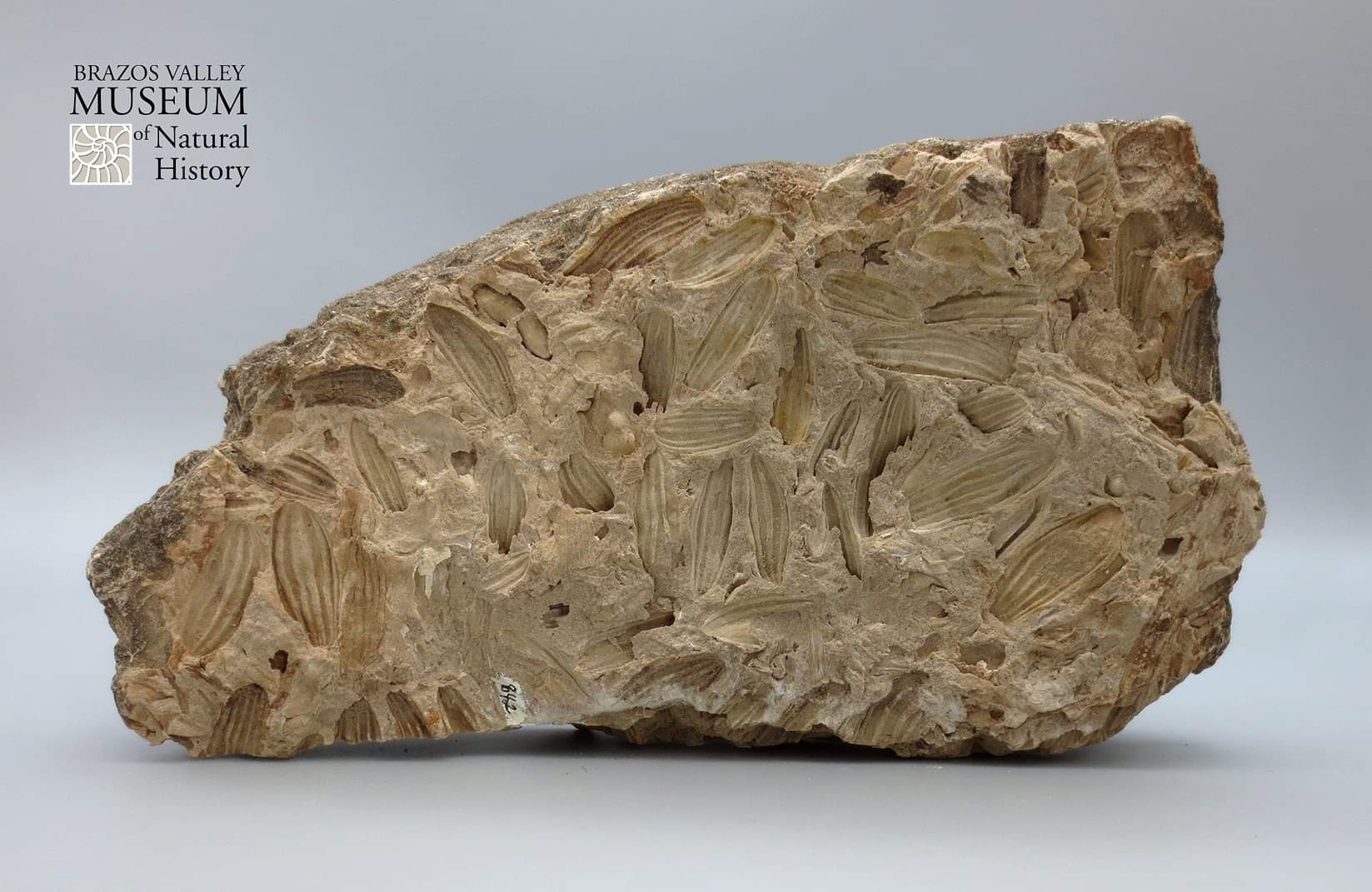
Endocarps (stones or pits of fruits) of Nyssa texana, an extinct type of tupelo from the late Eocene of Burleson County, Texas. Source: Brazos Valley Museum of Natural History, Bryan, Texas (image copyright Brazos Valley Museum of Natural History, all rights reserved, used for the Earth@Home project with permission).
Seed of Yua texana, an extinct species in the grape family from the late Eocene (likely Whitsett Formation), Trinity County, Texas. Modern relatives of this species are found only in Asia today. This image is a 2D model; you can zoom in or out using your mouse. Renderings of USNM (Smithsonian Institution) PAL 722035 and 722040 from micro-CT scans, uploaded by Steven Manchester (MorphoSource ID 000083446), commercial use not permitted.

Insects in amber from the Eocene Claiborne Formation of Arkansas. Left: Gall midge (MCZ Ent:PALE-26882). Right: Biting midge (MCZ Ent:PALE-26599). Scale bars = 250 µm (0.25 millimeters). Photos of specimens in the Museum of Comparative Zoology (MCZ), Harvard University (Creative Commons Attribution-NonCommercial-ShareAlike 3.0 Unported license, accessed via GBIF.org, images slightly cropped).
Neogene
Terrestrial deposits in eastern Texas, dating from the early Miocene (e.g., Fleming Formation, exposed near Toledo Bend Reservoir; Lampara Creek Fauna, southeastern Texas), include abundant bones and teeth of amphibians, reptiles, and rodents. Larger mammals are also present, including carnivores, tapirs, pigs, rhinos, horses, and bizarre extinct forms such as the large herbivore Moropus and the gomphothere Blancotherium. Miocene vertebrate remains also come near Fort Polk in western Louisiana.
The Coastal Plain’s Miocene sediments also contain petrified wood, including palm (Palmoxylon), the Texas state rock and Louisiana state fossil.
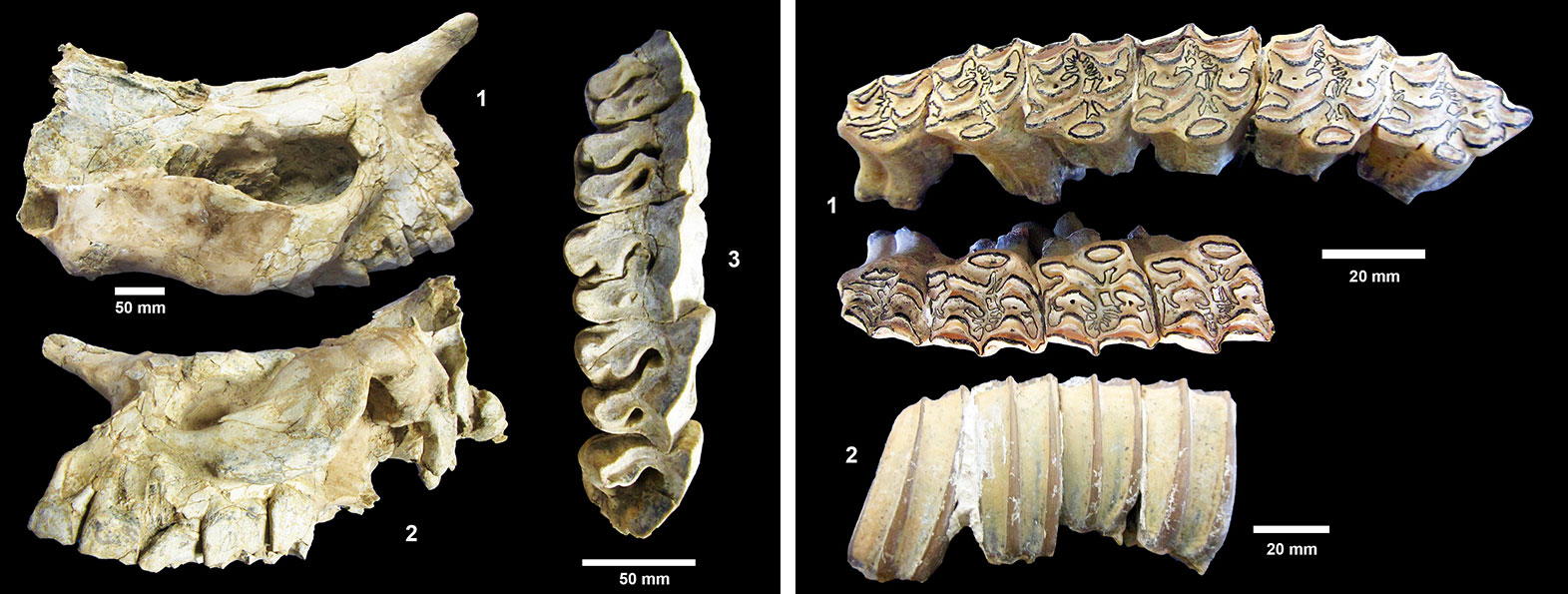
Fossil herbivores from the late Miocene Lapara Creek Fauna, southeastern Texas. Left: Parts of the skull (left, 1,2) and teeth (right, 3) of Teleocerus major, an extinct North American rhino. Right: Tops (1) and sides (2) of teeth of Cormohipparion occidentale, an extinct horse. Figures 90 and 99 from S. R. May (2019) Palaeontologia Electronica 22.1.15A (copyright Society of Vertebrate Paleontology, Creative Commons Attribution-NonCommercial-ShareAlike 4.0 International license, images cropped).

Lower jaw (left) and surface fo tooth (right) of Blancotherium buckerneri, a gomphothere (an extinct animal distantly related to modern elephants), late Miocene Lampara Creek Fauna, southeastern Texas. Figures 45 and 46 from S. R. May (2019) Palaeontologia Electronica 22.1.15A (copyright Society of Vertebrate Paleontology, Creative Commons Attribution-NonCommercial-ShareAlike 4.0 International license, images cropped).
Quaternary
By the Quaternary period, the glaciation of North America was underway. Many Neogene mammals had gone extinct by this time, yet mastodons, horses, and camels remained common. Fossils from this time are found on the Coastal Plain of Texas and Louisiana, and in the Mississippi River Valley in Louisiana, Arkansas, and the southeastern-most corner of Missouri. Pleistocene manatees are also known from Texas.
The youngest deposits of the Coastal Plain―for example, in the counties around Corpus Christi, Texas―contain the fossils of camels, saber-toothed cats, mammoths, glyptodonts, and dire wolves. Because they were the dominant life on land, and because their relatively large, heavy bones preserve more easily, it is easy to focus on Quaternary mammals; however, major groups of flora and fauna shared the landscape with these beasts, and their remains are occasionally found as well. For example, shells of freshwater bivalves are common, as well as those of land and freshwater gastropods. Petrified wood and pollen are also found.
Spotlight: Waco Mammoth National Monument
Waco Mammoth National Monument in McLennan County, central Texas, contains the fossil bones of 24 Columbian mammoths (Mammuthus columbi) and other Pleistocene mammals. The site, discovered in 1978, is the largest known concentration of a single herd of mammoths dying from the same event, which is believed to have been a flash flood. The site was designated a U.S. National Monument in 2015. (You can take a virtual tour of the Waco Mammoth National Monument shelter here).
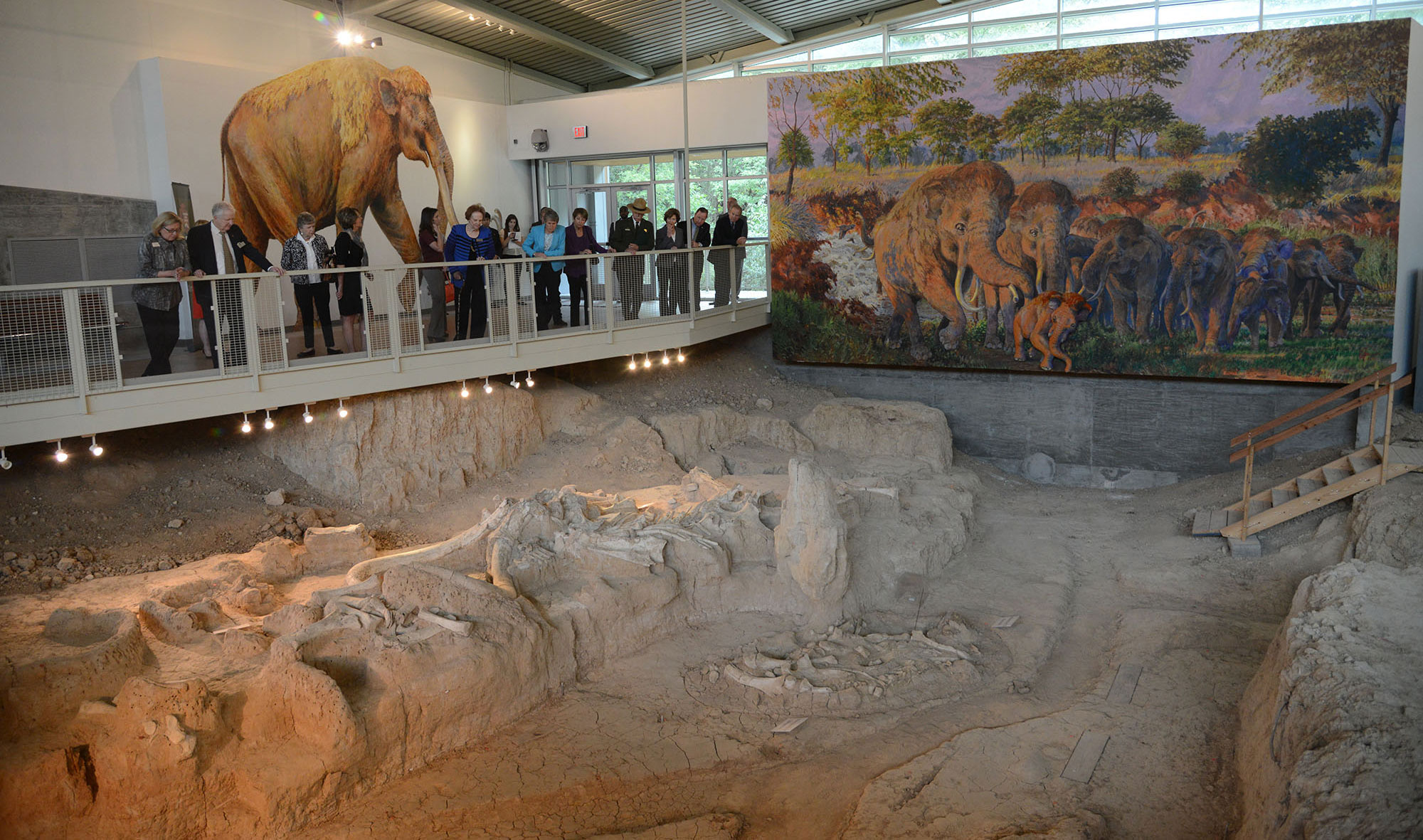
Celebration of the designation of Waco Mammoth National Monument in October 2015. Photographer not credited, U.S. Department of the Interior (Wikimedia Commons, Creative Commons Attribution-ShareAlike 2.0 Generic license, image cropped).
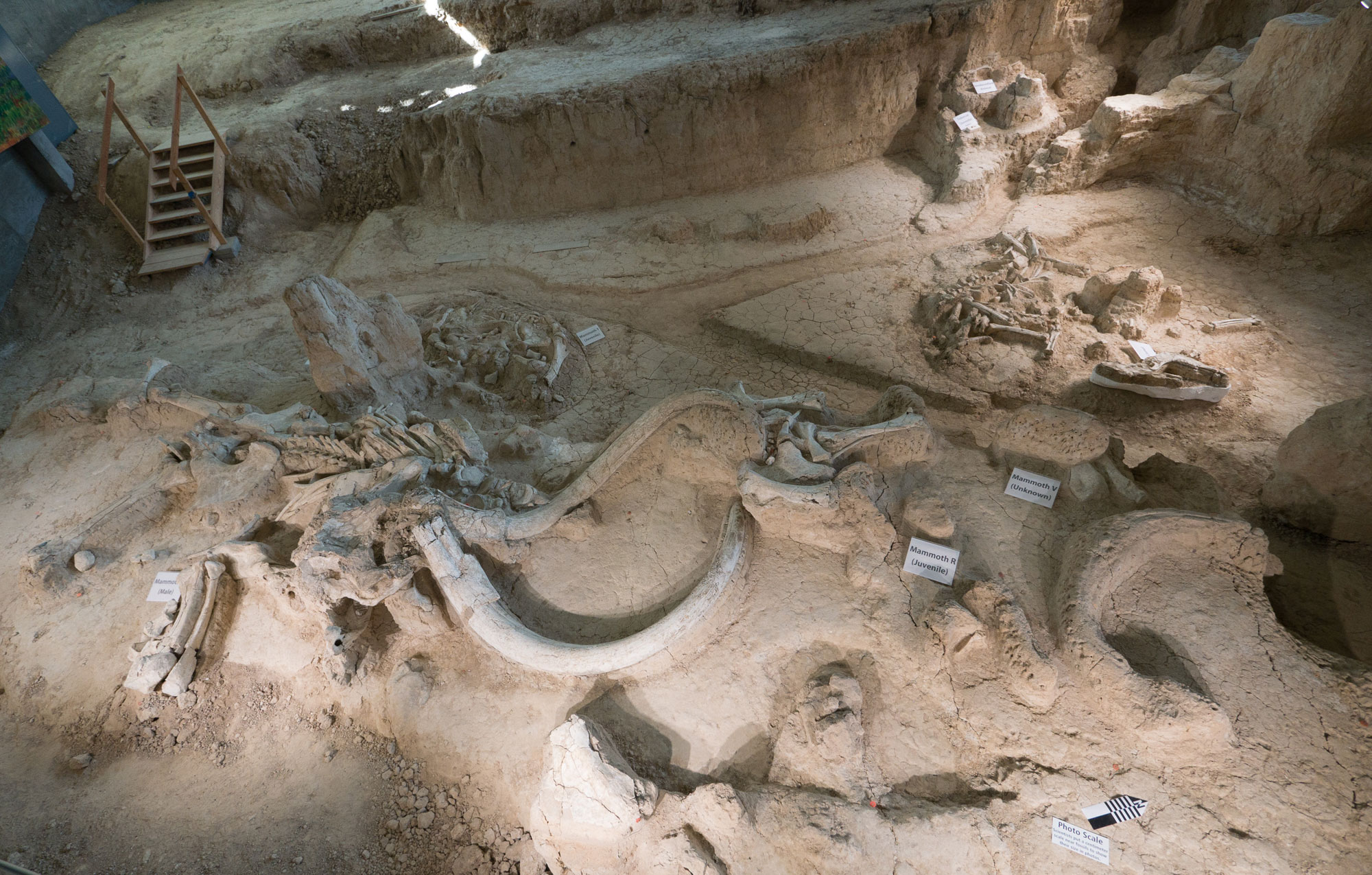
Excavation at Waco Mammoth National Monument. Skeletons of several Columbian mammoths are marked, including a male mammoth (left, with large tusks), a juvenile (right) and part of an unknown mammoth (behind the juvenile). Photo taken in 2017 by Jay Galvin (flickr, Creative Commons Attribution 2.0 Generic license, image cropped and resized).
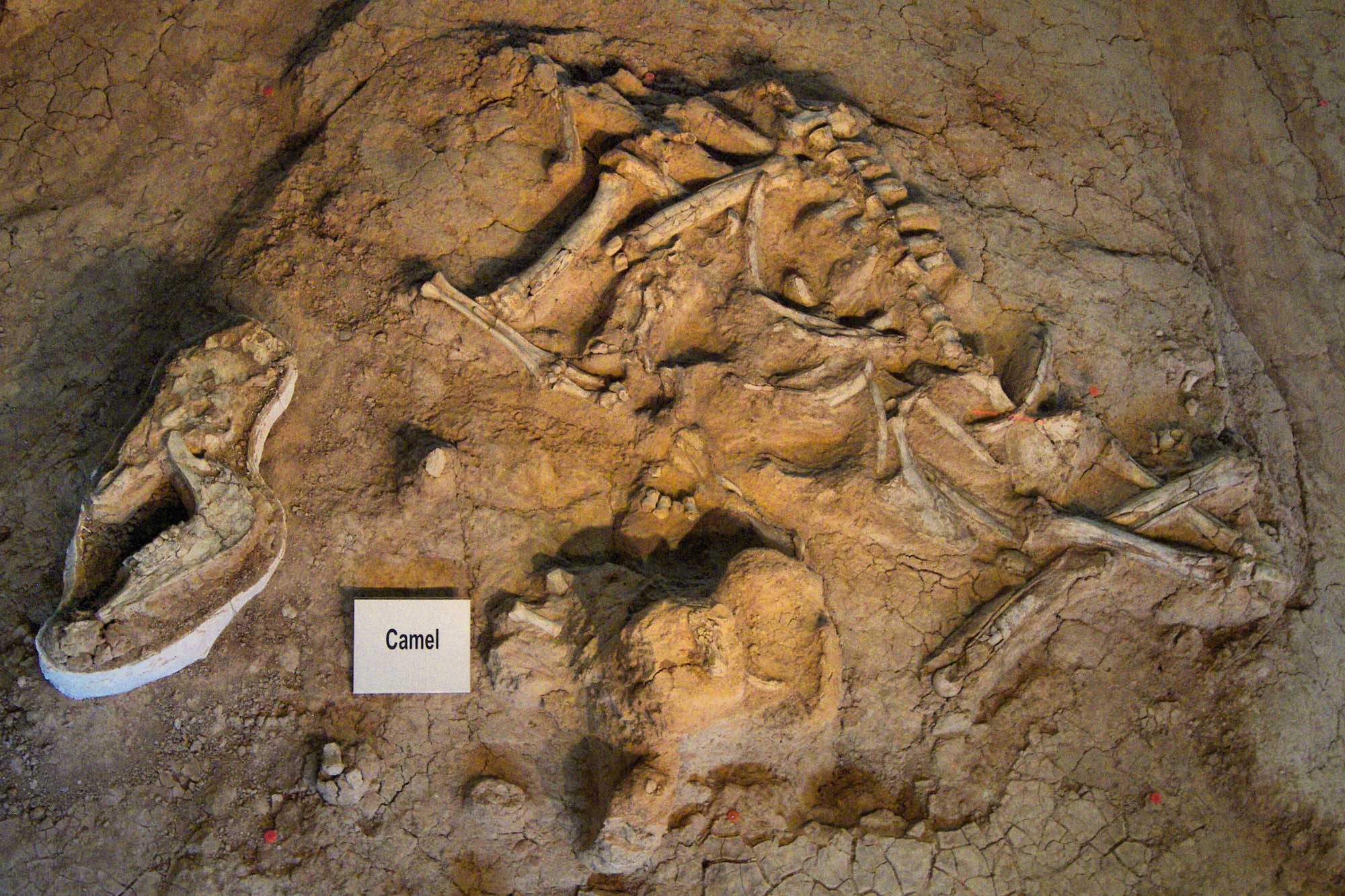
Fossil camel (Camelops hesternus) at Waco Mammoth National Monument. Note that the skull is on the left side fo the image, encircled by a plaster jacket. Photo by Larry D. Moore (Wikimedia Commons, Creative Commons Attribution-ShareAlike 3.0 Unported license, image resized).
Resources
Resources from the Paleontological Research Institution & partners
Cretaceous Atlas of Ancient Life, Western Interior Seaway (Colorado, Iowa, Kansas, Montana, Nebraska, New Mexico, North Dakota, Oklahoma, South Dakota, Texas, Utah, Wyoming): https://www.cretaceousatlas.org/geology/
Digital Atlas of Ancient Life Virtual Collection: https://www.digitalatlasofancientlife.org/vc/ (Virtual fossil collection featuring 3D models of fossil specimens sorted by group)
Digital Encyclopedia of Ancient Life: https://www.digitalatlasofancientlife.org/learn/
Earth@Home: Earth Science of the Southeastern U.S.: Fossils of the Coastal Plain (continues coverage of the Gulf Coastal Plain in Alabama, Florida, and Mississippi, as well as the Atlantic Coastal Plain north to Virginia): https://earthathome.org/hoe/se/fossils-cp/
Earth@Home: Quick guide to common fossils: https://earthathome.org/quick-faqs/quick-guide-common-fossils/



